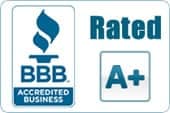If you have been informed that you have a problem with your main sewer pipe, you may be wondering which option is best for you – repair or full replacement. While every situation is a little different, here are some guidelines that may help you to understand which way to go, for best results.
Getting Started
When trying to decide between sewer line repair or replacement, the first thing you want to do is gather as much intel as you can. Since the vast majority of sewer line problems happen outside of the building’s foundation, the best starting point is usually a cleanout right where the line exits the building.
This will allow for much better cleaning of the pipe. It will also give you the proper access for a sewer video inspection and line location. These will tell you with near certainty what the problem is and where. This is important because quite often a second cleanout at the property line, or a small spot repair may be all that is needed. That knowledge alone can save you a LOT of money.
Here is the best way to go about it:
1 – Have the plumber install a foundation cleanout (skip this step if you already have one).
2 – Have him cable the line clear, and follow it up with a camera inspection.
3 – If a spot repair or property line cleanout is required, have the plumber make those repairs.
4 – If it looks like a new sewer line is needed, have the plumber credit the cost of the cleanout and camera work towards the new sewer line.
If you follow these steps, you really cannot go wrong. Every home and business building should have a cleanout at the foundation (or as close to it as possible), and a cleanout within the property easement (the 5’ or so section of land that is kind of a “neutral zone” between the property and the side walk).
Repair or Replace?
Here are some situations where it is pretty cut and dry which approach is the most economical and effective. We will start with the most common scenario. One thing to keep in mind is that the material the sewer line is made of under your house, is not necessarily the same as what it is once is leaves. There is a transition point, approximately 12” outside of the foundation where it could be anything.
The most common scenario is that your home will have a cast iron sewer line in the front yard that transitions to clay at, or near the sidewalk. That transition point is usually where the problems start, and they continue from there. In this case, the best course of action is to repair that section by installing a cleanout there (assuming the cast line is still strong). This will separate the sections of the line, as well as get you the repair. At that point the city should take care of any problems under the sidewalk/street, should they arise in the future.
On the other hand, if you have a clay, or asbestos sewer line in your front yard, or any time there are multiple problems, a replacement is usually the best bet. This is also the case if you have Orangeburg pipe (which is basically rolled and compressed tar paper).
There are also cases where there is a problem somewhere in the middle of the line, and a property line cleanout required, or maybe a short sewer line, but two cleanouts needed. In these cases, it can sometimes be more cost effective to pay a little extra to have the whole line replaced. This is more an option based on what is more important to you, so give this scenario some thought.
Finally, in a case where there is a “belly” in the line (loss of downward slope), or an offset in the pipe joints, a longer trench needs to be used to replace the amount of pipe needed to remedy the problem, so a new sewer line may be your best bet there as well. This really depends on the situation, but keep it in mind.
In either case, the 4 steps mentioned above are the best place to start, and by choosing an Allstar Plumber to do them for you, you know you will always have your sewer line repair or replacement done correctly, and with your best interests in mind. We guarantee it!




